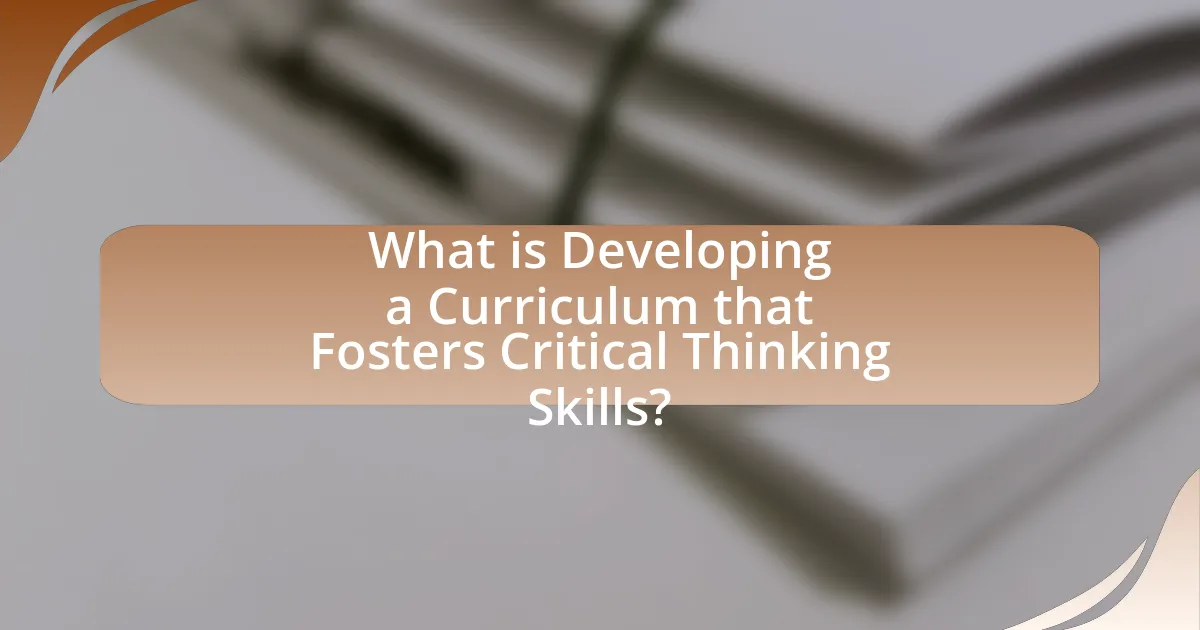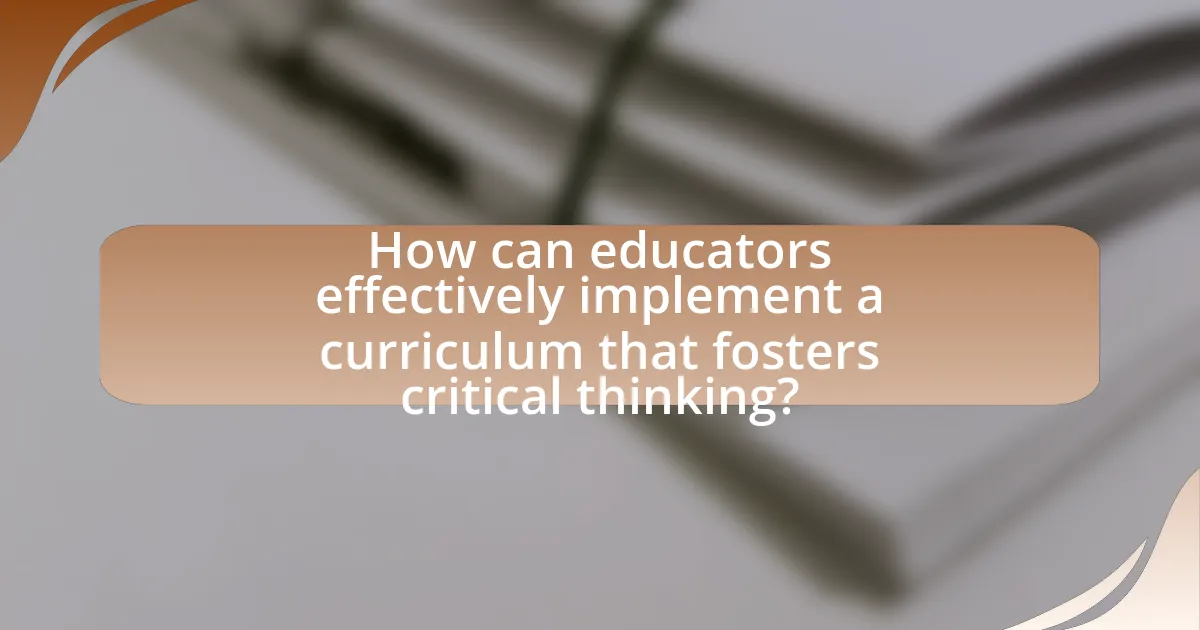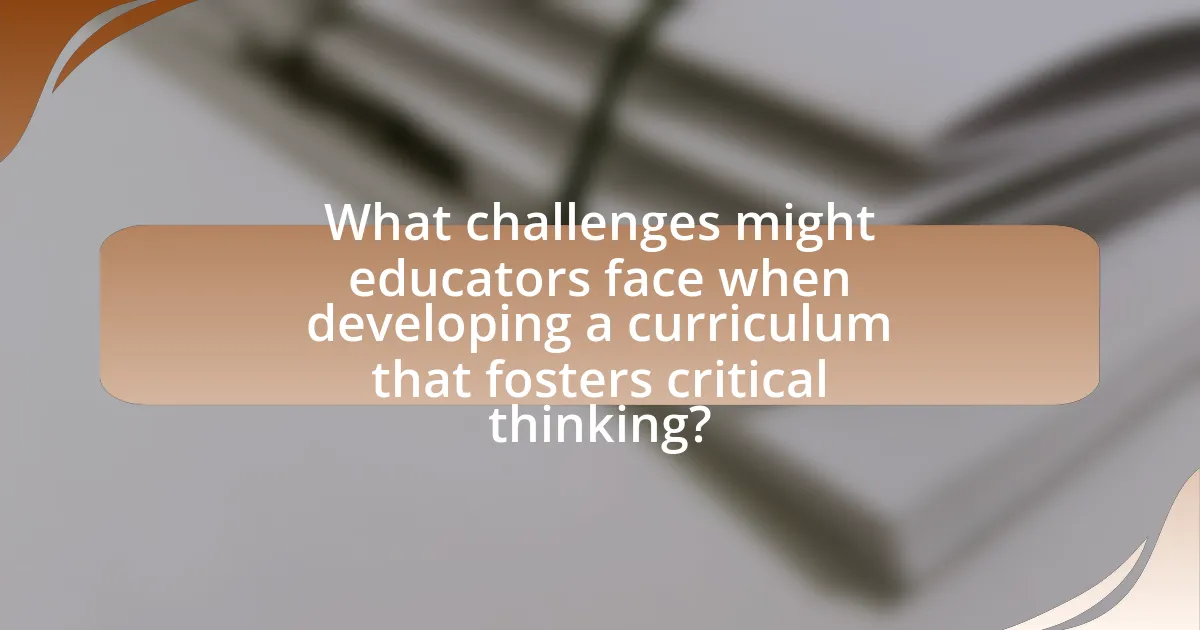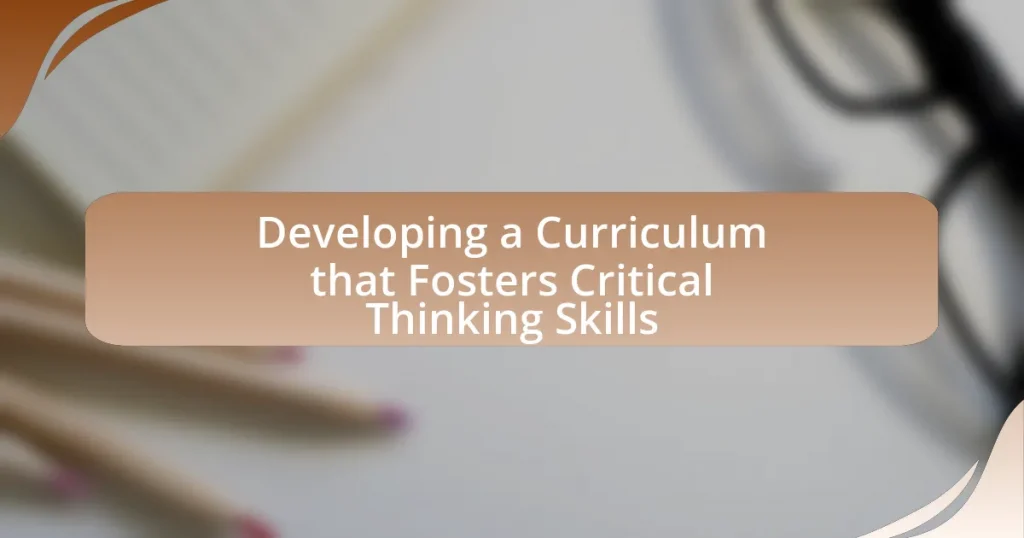Developing a curriculum that fosters critical thinking skills involves creating educational frameworks that encourage students to analyze, evaluate, and synthesize information. This article outlines the importance of critical thinking in education, highlighting its role in enhancing student learning outcomes and preparing them for real-world challenges. Key components of critical thinking, such as analysis, evaluation, and problem-solving, are discussed, along with strategies for implementing inquiry-based learning and effective assessment practices. Additionally, the article addresses challenges educators may face in curriculum development and emphasizes the significance of professional development in fostering critical thinking skills among students.

What is Developing a Curriculum that Fosters Critical Thinking Skills?
Developing a curriculum that fosters critical thinking skills involves creating educational frameworks and learning experiences that encourage students to analyze, evaluate, and synthesize information effectively. This approach emphasizes inquiry-based learning, problem-solving, and the application of knowledge in real-world contexts. Research indicates that curricula designed with critical thinking in mind can lead to improved student outcomes, as evidenced by studies showing that students engaged in such programs demonstrate higher levels of analytical skills and creativity. For instance, a study published in the “Journal of Educational Psychology” found that students who participated in critical thinking-focused curricula scored significantly higher on assessments measuring these skills compared to those in traditional learning environments.
Why is critical thinking important in education?
Critical thinking is important in education because it equips students with the ability to analyze information, make reasoned judgments, and solve complex problems. This skill set is essential for navigating the vast amounts of information available in today’s digital age, where misinformation is prevalent. Research indicates that students who engage in critical thinking are better prepared for real-world challenges, as they can evaluate arguments, identify biases, and develop coherent conclusions. For instance, a study published in the Journal of Educational Psychology found that students who participated in critical thinking exercises showed significant improvements in their academic performance and problem-solving abilities. Thus, fostering critical thinking in education enhances students’ cognitive skills and prepares them for future success.
What are the key components of critical thinking?
The key components of critical thinking are analysis, evaluation, inference, explanation, and problem-solving. Analysis involves breaking down complex information into manageable parts to understand it better. Evaluation refers to assessing the credibility and relevance of information sources. Inference is the ability to draw logical conclusions from available evidence. Explanation entails clearly articulating reasoning and justifying conclusions. Problem-solving involves identifying solutions to complex issues through systematic approaches. These components are essential for fostering critical thinking skills in educational curricula, as they enable learners to engage deeply with content and develop independent thought processes.
How does critical thinking impact student learning outcomes?
Critical thinking significantly enhances student learning outcomes by promoting deeper understanding and retention of knowledge. When students engage in critical thinking, they analyze, evaluate, and synthesize information, leading to improved problem-solving skills and greater academic performance. Research indicates that students who develop critical thinking skills demonstrate higher levels of achievement in assessments; for instance, a study published in the Journal of Educational Psychology found that students trained in critical thinking scored 15% higher on standardized tests compared to their peers who did not receive such training. This evidence underscores the importance of integrating critical thinking into curricula to foster better educational results.
What are the characteristics of a curriculum that fosters critical thinking?
A curriculum that fosters critical thinking is characterized by its emphasis on inquiry-based learning, interdisciplinary approaches, and the integration of real-world problems. Inquiry-based learning encourages students to ask questions, explore, and engage in problem-solving, which enhances their analytical skills. Interdisciplinary approaches allow students to make connections across different subjects, promoting a broader understanding of complex issues. Additionally, integrating real-world problems into the curriculum helps students apply their critical thinking skills in practical contexts, making learning relevant and impactful. Research by Facione (2011) highlights that curricula designed with these characteristics significantly improve students’ critical thinking abilities, as they actively engage in the learning process rather than passively receiving information.
How can curriculum design promote inquiry-based learning?
Curriculum design can promote inquiry-based learning by integrating open-ended questions and real-world problems that encourage students to explore and investigate. This approach fosters critical thinking as students engage in hands-on activities, collaborate with peers, and reflect on their learning processes. Research indicates that inquiry-based learning enhances student engagement and retention of knowledge, as evidenced by a study published in the Journal of Educational Psychology, which found that students in inquiry-based environments demonstrated higher levels of critical thinking and problem-solving skills compared to traditional learning settings.
What role do assessments play in fostering critical thinking?
Assessments play a crucial role in fostering critical thinking by providing structured opportunities for students to analyze, evaluate, and synthesize information. Through various assessment formats, such as open-ended questions and problem-solving tasks, educators can gauge students’ ability to apply critical thinking skills in real-world contexts. Research indicates that formative assessments, which offer feedback during the learning process, significantly enhance students’ critical thinking abilities by encouraging reflection and self-assessment. For instance, a study published in the “Journal of Educational Psychology” by Black and Wiliam (1998) found that effective assessment practices lead to improved learning outcomes, including enhanced critical thinking skills.

How can educators effectively implement a curriculum that fosters critical thinking?
Educators can effectively implement a curriculum that fosters critical thinking by integrating inquiry-based learning, which encourages students to ask questions, explore, and engage in problem-solving activities. This approach promotes active learning and allows students to develop analytical skills through real-world applications. Research shows that inquiry-based learning enhances critical thinking abilities; for instance, a study by the National Research Council found that students engaged in such methods demonstrate improved reasoning and problem-solving skills compared to traditional teaching methods. By incorporating collaborative projects, discussions, and reflective practices, educators can create an environment that nurtures critical thinking and prepares students for complex decision-making in their future endeavors.
What strategies can teachers use to encourage critical thinking?
Teachers can encourage critical thinking by implementing strategies such as Socratic questioning, problem-based learning, and collaborative group work. Socratic questioning promotes deeper understanding by challenging students to think critically about their responses and assumptions. Problem-based learning engages students in real-world scenarios, requiring them to analyze information and develop solutions, which fosters critical thinking skills. Collaborative group work allows students to share diverse perspectives, enhancing their ability to evaluate arguments and reason effectively. Research indicates that these strategies significantly improve students’ critical thinking abilities, as evidenced by studies showing increased analytical skills and problem-solving capabilities in classrooms that utilize these methods.
How can collaborative learning enhance critical thinking skills?
Collaborative learning enhances critical thinking skills by promoting active engagement and diverse perspectives among learners. When individuals work together, they are exposed to different viewpoints, which challenges their own assumptions and encourages deeper analysis of concepts. Research by Johnson and Johnson (1994) indicates that cooperative learning environments lead to higher achievement and greater critical thinking abilities compared to competitive or individualistic settings. This interaction fosters skills such as problem-solving, evaluation of arguments, and the ability to synthesize information, all of which are essential components of critical thinking.
What types of questions should educators ask to stimulate critical thinking?
Educators should ask open-ended questions, analytical questions, and evaluative questions to stimulate critical thinking. Open-ended questions encourage students to explore multiple perspectives and articulate their reasoning, such as “What are the implications of this theory?” Analytical questions prompt students to break down complex ideas, for example, “How does this concept relate to what we learned previously?” Evaluative questions challenge students to assess the validity of arguments, such as “What criteria would you use to judge the effectiveness of this solution?” Research indicates that such questioning techniques enhance cognitive engagement and promote deeper understanding, as supported by studies in educational psychology that emphasize the importance of inquiry-based learning in developing critical thinking skills.
What resources are available for developing a critical thinking curriculum?
Resources available for developing a critical thinking curriculum include educational frameworks, instructional materials, and assessment tools. Notable frameworks such as the Critical Thinking Framework by the Foundation for Critical Thinking provide guidelines for integrating critical thinking into various subjects. Instructional materials can be found in textbooks like “Teaching Critical Thinking: Practical Wisdom” by bell hooks, which offers strategies for fostering critical thinking in the classroom. Additionally, assessment tools like the California Critical Thinking Skills Test (CCTST) measure students’ critical thinking abilities, providing educators with data to refine their curriculum. These resources collectively support the creation of effective critical thinking curricula.
Which books and materials are recommended for educators?
Recommended books and materials for educators focusing on developing a curriculum that fosters critical thinking skills include “Teaching Critical Thinking: Practical Wisdom” by bell hooks, which emphasizes the importance of critical pedagogy, and “Critical Thinking: A Beginner’s Guide” by Sharon M. Kaye, which provides foundational concepts and practical applications. Additionally, “The Critical Thinking Toolkit” by Dr. Randy K. Harris offers educators strategies and tools to enhance critical thinking in the classroom. These resources are validated by their widespread use in educational settings and their positive impact on teaching methodologies aimed at improving students’ analytical skills.
How can technology be integrated to support critical thinking?
Technology can be integrated to support critical thinking by utilizing interactive tools and platforms that encourage analysis, evaluation, and synthesis of information. For instance, online discussion forums and collaborative platforms like Google Docs allow students to engage in peer review and debate, fostering deeper understanding and critical evaluation of diverse perspectives. Research indicates that the use of technology in education, such as simulations and problem-based learning environments, enhances students’ ability to think critically by providing real-world contexts for applying their knowledge. A study by the National Education Association found that technology-rich environments significantly improve students’ critical thinking skills, as they require learners to assess information critically and make informed decisions.

What challenges might educators face when developing a curriculum that fosters critical thinking?
Educators face several challenges when developing a curriculum that fosters critical thinking, including a lack of resources, resistance to change, and varying student readiness levels. Limited access to training and materials can hinder the implementation of innovative teaching strategies essential for promoting critical thinking. Additionally, some educators may resist adopting new methodologies due to comfort with traditional teaching practices, which can impede curriculum development. Furthermore, students come with diverse backgrounds and skill sets, making it difficult to create a one-size-fits-all approach that effectively nurtures critical thinking across the board. These challenges highlight the complexities involved in designing an effective curriculum aimed at enhancing critical thinking skills.
How can resistance to change be addressed in educational settings?
Resistance to change in educational settings can be addressed by fostering open communication and involving stakeholders in the change process. Engaging teachers, students, and parents in discussions about the benefits of new curricula enhances buy-in and reduces apprehension. Research indicates that when educators are included in decision-making, their commitment to implementing changes increases, as seen in a study by Fullan (2007), which emphasizes the importance of collaboration in educational reform. Additionally, providing professional development and support helps educators adapt to new methodologies, thereby easing the transition and promoting a culture of continuous improvement.
What are common misconceptions about critical thinking in education?
Common misconceptions about critical thinking in education include the belief that it is solely about acquiring knowledge or that it can be taught in isolation from other subjects. Many educators mistakenly think that critical thinking is synonymous with being critical or negative, rather than understanding it as a constructive process of analysis and evaluation. Additionally, there is a misconception that critical thinking skills are innate and cannot be developed through structured teaching methods. Research indicates that critical thinking can be effectively fostered through specific instructional strategies, such as inquiry-based learning and collaborative problem-solving, which integrate critical thinking into various subjects rather than treating it as a standalone skill.
How can educators measure the effectiveness of their curriculum?
Educators can measure the effectiveness of their curriculum by utilizing a combination of formative and summative assessments, along with student feedback and performance data. Formative assessments, such as quizzes and class discussions, provide ongoing insights into student understanding and engagement, while summative assessments, like standardized tests and final projects, evaluate overall learning outcomes. Research indicates that schools employing data-driven decision-making, such as analyzing student performance metrics, can significantly enhance curriculum effectiveness. For instance, a study by the Institute of Education Sciences found that schools that regularly assess and adjust their curricula based on student performance data improve student achievement by an average of 10%. Additionally, gathering qualitative feedback from students about their learning experiences can help educators identify areas for improvement in fostering critical thinking skills.
What best practices should educators follow when developing a critical thinking curriculum?
Educators should incorporate active learning strategies when developing a critical thinking curriculum. Active learning engages students in the learning process, promoting deeper understanding and retention of concepts. Research indicates that methods such as problem-based learning, collaborative projects, and Socratic questioning significantly enhance critical thinking skills. For instance, a study published in the Journal of Educational Psychology found that students who participated in problem-based learning scored higher on critical thinking assessments compared to those who received traditional instruction. Additionally, integrating real-world scenarios into lessons allows students to apply critical thinking in practical contexts, further solidifying their skills.
How can continuous feedback improve curriculum effectiveness?
Continuous feedback enhances curriculum effectiveness by allowing educators to make timely adjustments based on student performance and engagement. This iterative process ensures that the curriculum remains relevant and aligned with learning objectives, ultimately fostering critical thinking skills. Research indicates that when students receive regular feedback, they demonstrate improved understanding and retention of material, as evidenced by a study published in the “Journal of Educational Psychology,” which found that students who received continuous feedback scored 20% higher on assessments compared to those who did not. This data underscores the importance of integrating continuous feedback mechanisms into curriculum design to optimize learning outcomes.
What role does professional development play in fostering critical thinking skills?
Professional development plays a crucial role in fostering critical thinking skills by equipping educators with the necessary strategies and tools to enhance their teaching practices. Through targeted training programs, educators learn to implement instructional methods that promote inquiry, analysis, and evaluation among students. Research indicates that professional development focused on critical thinking can lead to improved student outcomes; for instance, a study by the National Staff Development Council found that teachers who participated in professional development aimed at enhancing critical thinking saw a 20% increase in student engagement and performance in critical thinking tasks. This evidence underscores the importance of continuous professional growth in cultivating an educational environment that prioritizes and develops critical thinking skills.










